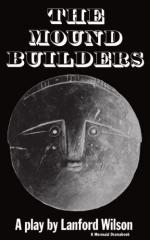Average rainy red average DOLICHO- river river BRACHY- cephalic. Skull. Skull. Cephalic.
Longitudinal diameter 7.24 7.3 in 6.7 6.62
Parietal diameter 5.47 5.8 5.5 5.45
Vertical " 5.42 6.2 5.8 5.30
Frontal " 4.36 4.2 3.7 4.24
Intermastoid Arch 14.67 15.3 15.6 14.63
Intermastoid line 4.23 5.8 4.3 4.25
Occipito frontal Arch 14.62 17.0 13.8 13.85
Horizontal circumference 20.29 22.3 19.6 19.44
From this it will be seen that the Red River mound skulls agree with the Toltecan Brachycephalic type; and the Rainy River skull while not so distinctly Brachycephalic yet is considerably above the average of the Dolichocephalic type.
2. Wood. As already stated it is only in some of the mounds that charred wood is found. This specimen is from the mound at Contcheteheng, at the head of Rainy River. It stands beside the Rapids. This mound has supplied many interesting remains. From this fact as well as from its situation, I would hazard the opinion that here, as at the great Rainy River Falls, three miles farther down, there were villages in the old mound building days. It is a fact worthy of notice that the site of the first French Fort on Rainy River, St. Pierre built by Verandrye in 1731, was a few hundred yards from this mound.
3. Bark. Specimens of birch bark were found near by the bones. It was no doubt originally used for swathing or wrapping the corpses buried. That a soft decayable substance such as bark, should have lasted while a number of bones had decayed may seem strange. No doubt this may be explained in the same way as the presence among the remains in Hochelaga, on the Island of Montreal, of preserved fragments of maize, viz., by its having been scorched. The pieces of bark seem to have been hardened by scorching.
4. Earth. The main earth of the mound is plainly the same as that of the soil surrounding it. By what means the earth was piled up, is a question for speculation. It seems a matter of small moment. Possibly that the earth was carried in baskets, or vessels of considerable size is sufficient to account for it. My theory is that the mound was not erected by a vast company of busy workers as were the pyramids, but that it was begun at first for purposes of observation, that as interments were from time to time made in it sufficient earth was carried up to effect the purpose, until in centuries the enormous aggregate of earth was formed. Among the earth of the mound are also found in spots, quantities of red and yellow ochre. The fact that the skulls




